Welcome, fellow wanderers, thrill-seekers and culture enthusiasts!
Ever contemplated embarking on a journey to India but did not know where to start? This is a real headache as there are so many amazing things to do! The dilemma of choosing among the myriad of attractions in a country steeped in nearly five millennia of history can be daunting. If you cannot make up your mind, start with the tried and true choice - visit the Golden Triangle - the most popular tourist circuit in India. India is the perfect blend of modern and ancient culture and the Golden Triangle of India is the best example of the country’s vibrant culture and colors.
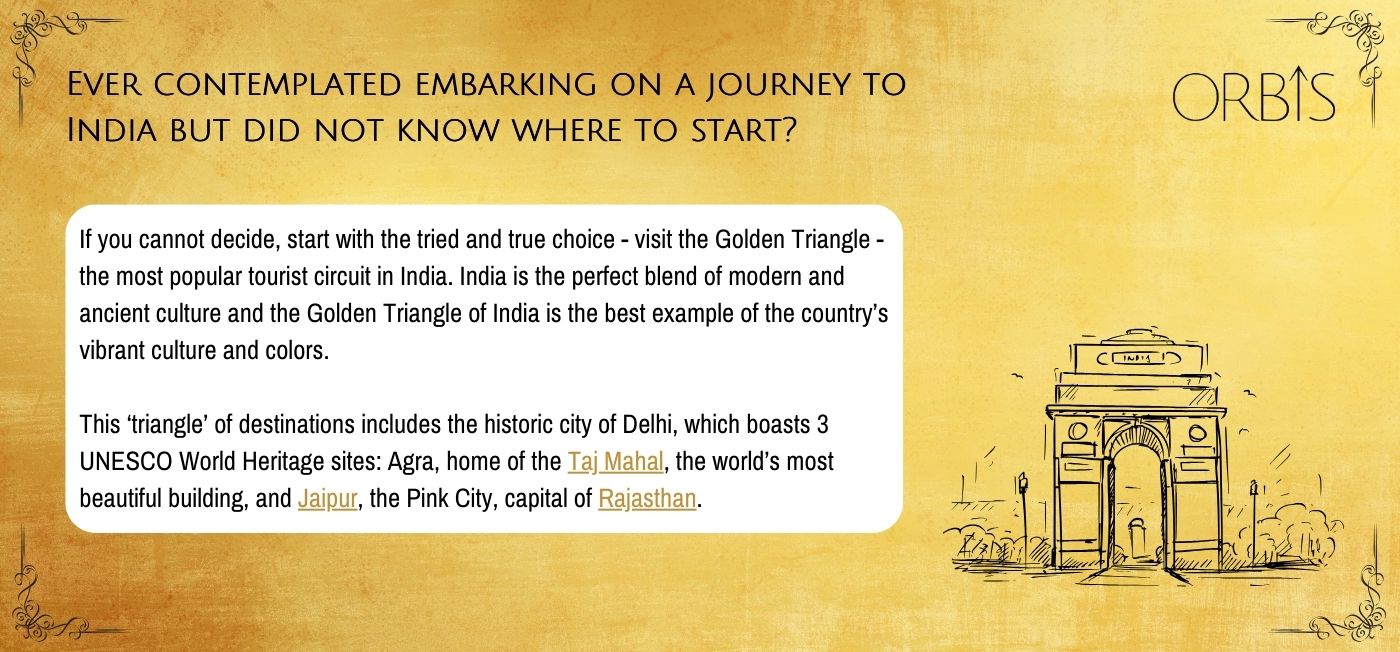
This ‘triangle’ of destinations includes the historic city of Delhi, which boasts 3 UNESCO World Heritage sites: Agra, home of the Taj Mahal, the world’s most beautiful building, and Jaipur, the Pink City, capital of Rajasthan.
Each destination on your trip on the Golden Triangle India tour represents a different tradition, culture, ancient architecture, delicious cuisine, lively and colorful markets and bazaars, and a wide range of accommodations suited to every class. This ultimate travel guide is your passport to an unforgettable experience in this enchanting part of the Indian subcontinent.
Highlights of the Golden Triangle India Tour
- Experience the diversity of Indian culture and the rich heritage of India.
- Enjoy a thrilling rickshaw ride through the narrow lanes of Chandani Chowk Bazaar and Spice Market in Chandani Chowk.
- Explore the charismatic charm of Old Delhi - the Mughal’s capital - and New Delhi - the modern capital of India, developed in the British Era.Enjoy sumptuous Indian cuisine and mouthwatering street foods.
- Sunrise visits the Taj Mahal, one of the world’s magnificent masterpieces and wonders.
- Explore the Pink City of Jaipur, a UNESCO World Heritage Site.
- Discover the royal lifestyle and experience it by staying in a heritage property in Jaipur.
- Pass through the rural villages
- Walk through the colorful and vibrant markets of Delhi, Jaipur and Agra.
Unveiling the charm of Old Delhi
Delhi, a fascinating blend of city and union territory, is the proud host of India’s capital. With a history dating back to the 6th century BC, this metropolis is a treasure trove of ancient remains and monuments, offering a captivating journey through time. History enthusiasts, in particular, find themselves drawn to the heart of Old Delhi, where the Chandani Chowk market unfolds its tales.
Constructed during the reign of the illusions of Mughal Emperor Shah Jahan, the visionary behind the Taj Mahal, Chandani Chowk is a living testament to the emperor’s architectural prowess. This market exudes beauty and vibrancy, today as a focal point of attraction. Wander through its bustling lanes and you will find yourself immersed in a sensory experience.
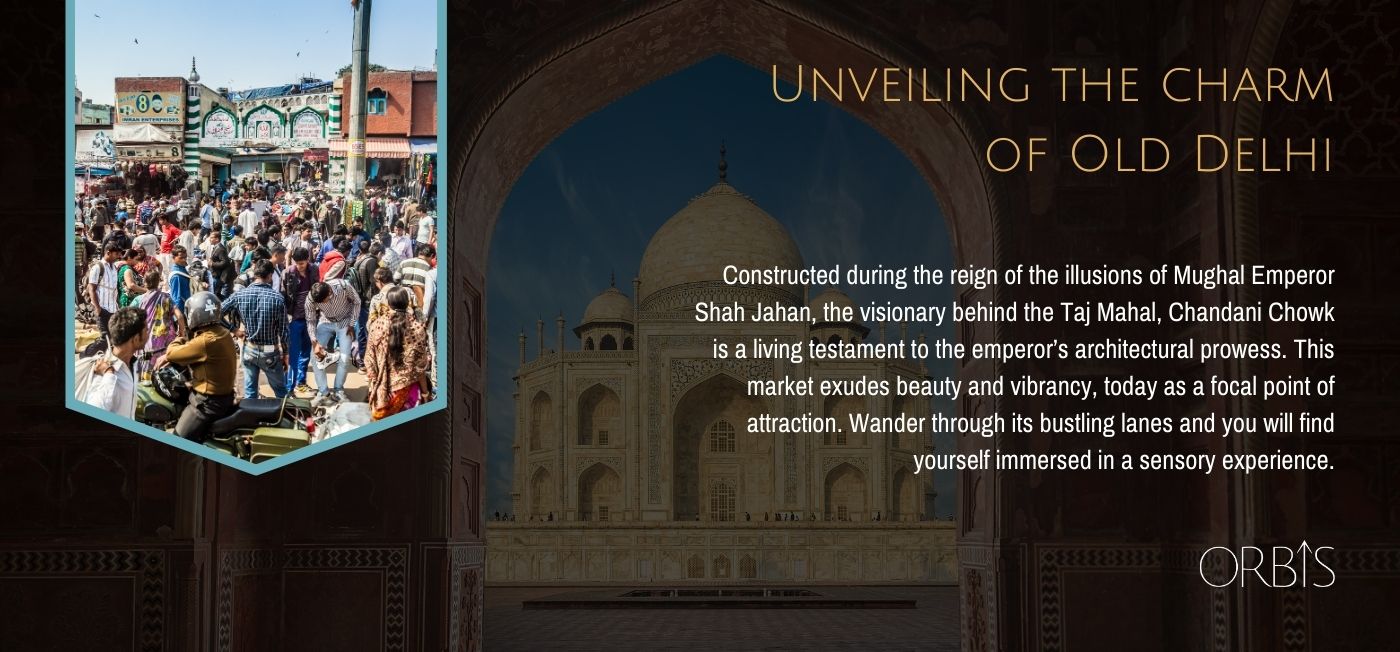
Chandani Chowk is renowned for its exotic spice stalls, reminiscent of a time when medieval European nobility held an enduring fascination for these aromatic treasures. The market remains a captivating showcase of the past, where the echoes of history resonate through its vibrant atmosphere.
What to do?
Steeping into its bustling lanes is like entering a time capsule, where each corner reveals stories from centuries past. Here is a special guide to immerse yourself in the magic of Chandani Chowk.
Visit Jama Masjid
A stone’s throw away from Chandani Chowk, explore the grandeur of Jama Masjid. This magnificent mosque, with its imposing red sandstone architecture, offers a serene escape from the bustling market.
Stroll through Khari Baoli
As you walk through Khari Baoli, the spice market of Chandani Chowk, let the fragrant aroma of exotic spices envelop you. The vibrant displays and myriad colors make this one of the oldest and largest spice markets in Asia.
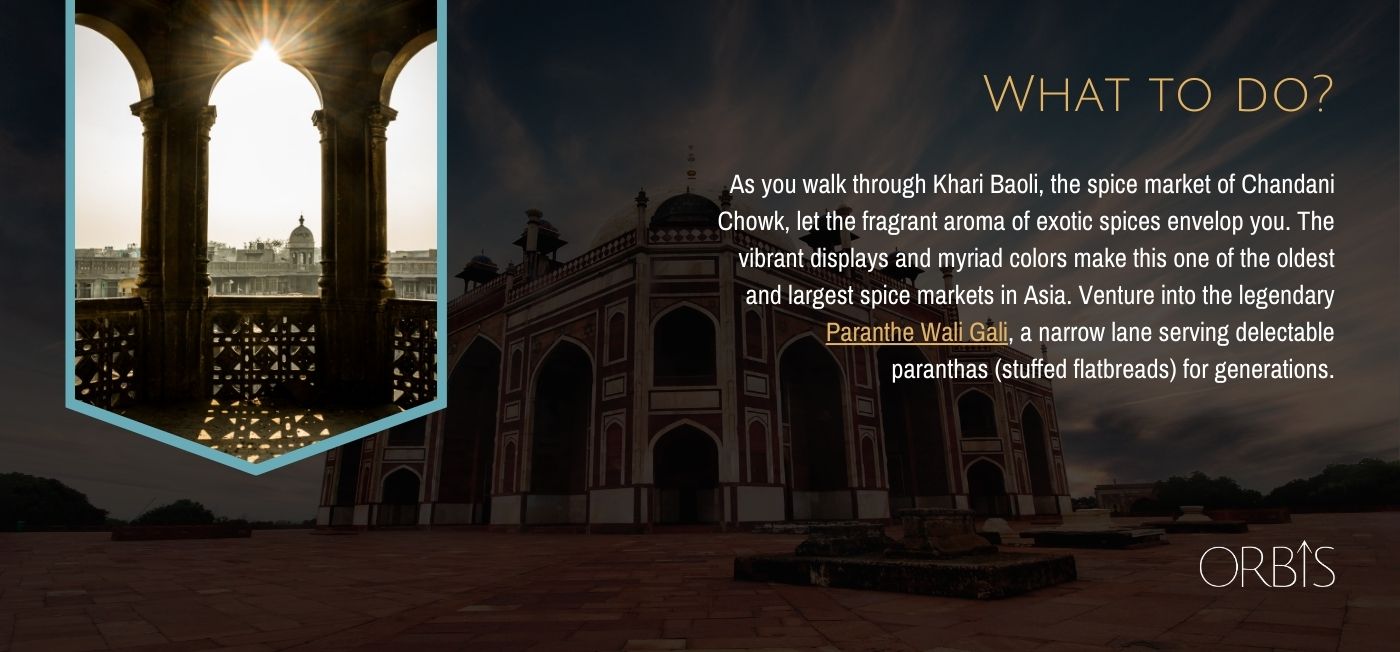
Paranthe Wali Gali - Must-visit
Venture into the legendary Paranthe Wali Gali, a narrow lane serving delectable paranthas (stuffed flatbreads) for generations. From sweet to savory, the variety is endless and each bite is a burst of flavors.
Baburam Paranthewala at Paranthe Wali Gali is known for its robust flavours and wholesomeness. When in Chandani Chowk, savor the flavor of Papad Parantha, Meva Parantha, Karela Parantha, Dal Aloo Parantha and Lemon Parantha.
Chandani Chowk is not merely a market; it is a sensory expedition through time and flavors. Whether you are a history buff, a foodie or a shopaholic, this vibrant locale promises an unforgettable experience that encapsulates the essence of the charm of Old Delhi.
The enduring legacy of Qutab Minar
Built to commemorate the victory of Islamic rule over Delhi’s Hindi rulers, the Qutab Minar represents not only architectural brilliance but also the cultural and historical shifts of the era.
The Qutab Minar complex is an extraordinary destination that should not be overlooked, especially for those with limited time in Delhi. Positioned as the top recommendation for time-strapped visitors, this complex unfolds a tapestry of splendid monuments and structures spanning a multitude of dynasties in Indian history.
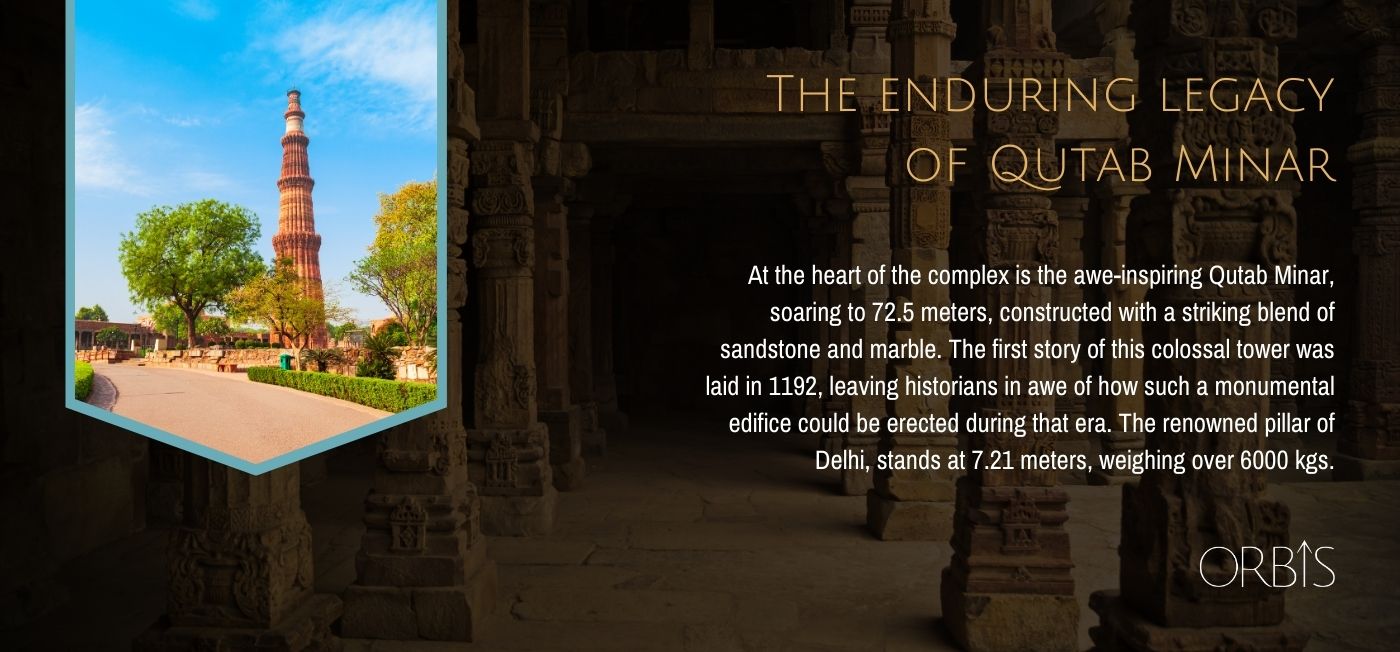
At the heart of the complex is the awe-inspiring Qutab Minar, soaring to 72.5 meters, constructed with a striking blend of sandstone and marble. The first story of this colossal tower was laid in 1192, leaving historians in awe of how such a monumental edifice could be erected during that era. The renowned pillar of Delhi, stands at 7.21 meters, weighing over 6000 kgs.
Recognizing its historical and cultural significance, the Qutab Minar complex was declared a UNESCO World Heritage Site in 1993, further solidifying its global importance.
Delhi, beyond the Qutab Minar complex, unfolds a plethora of exciting destinations. The architecturally resplendent Red Fort, India’s largest mosque - the Jama Masjid, with a capacity to accommodate 25,000 worshippers, and the solemn Raj Ghat, the cremation site of Mahatma Gandhi, beckon your exploration.
Do not miss the opportunity to marvel at the grandeur of Humayun’s Tomb, a magnificent garden tomb that stands as a testament to architectural brilliance.
The Taj Mahal - An extravagant love story
Approximately 200 km south of Delhi lies to glorious Taj Mahal. Nearly every visitor to Agra naturally gravitates towards the Taj Mahal - an architectural marvel deemed a wonder of the world and unquestionably deserving of a visit.
To optimize the experience, it is recommended to explore the Taj Mahal early in the morning when it opens its doors. The morning sunlight enhances its brilliance, and the crowds are minimal during this time. Travelers are advised to carry minimal belongings, restricted to essentials like a water bottle and a camera, as many items, including notebooks, pens, and tripods, are prohibited.
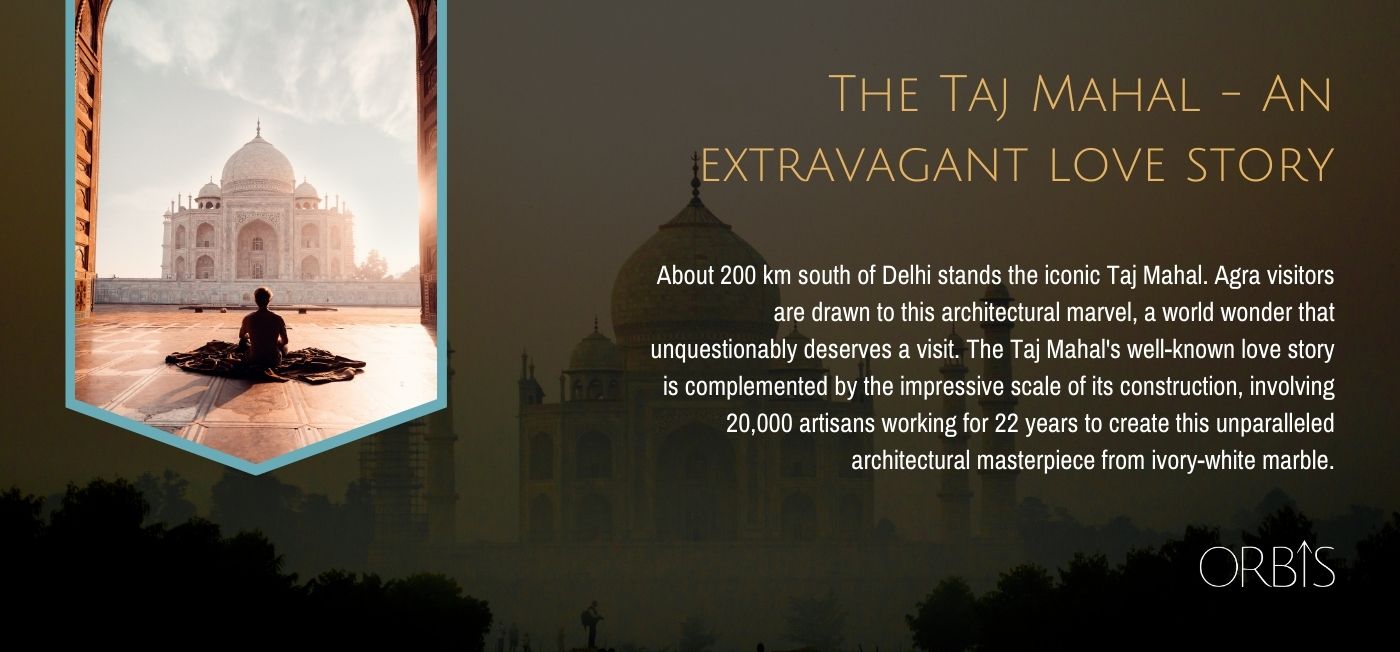
The love story behind the Taj Mahal is well-known, but the scale of its construction is less so. It took 20,000 artisans laboring for 22 years to build the magnificent memorial out of ivory-white marble. The result was an unparalleled architectural masterpiece.
Culinary delicacies in Agra
When in Agra, savor the rich flavors of Mughlai cuisine at Pinch of Spice. From succulent kebabs to aromatic biryanis, this restaurant offers a culinary journey fit for royalty. Try the iconic Bedai with Aloo ki Sabzi for breakfast or indulge in local chaats and kachoris as you explore the city. Head to Kinari Bazaar to sample the authentic Agra Ka Petha. This sugary delight, often infused with flavors like kesar and paan, is a must-try local speciality.
Unique experiences in Agra
Escape the city’s hustle and bustle with a visit to Bateshwar, a serene town along the Yamuna River. Explore its temples and ghats, often called ‘mini Varanasi,’ and enjoy the peaceful surroundings. Experience the thrill of a Chambal Safari, an excursion that takes you along the Chambal River. Encounter diverse wildlife, including gharials, turtles and a variety of bird species.

Conclude your day with a serene sunset at Mehtab Bagh, a garden across the Yamuna River offering a breathtaking view of the Taj Mahal. The changing hues of the sky make it a picture-perfect moment.
Let its charm and captivate you as you delve into its history, flavors and the warmth of its people. Dial +91 971-200-0912 to book your Golden Triangle India tour today.
En-route stops on the way from Agra to Jaipur
On the journey from Agra to Jaipur, another iconic Mughal city, Fatehpur Sikri, is a captivating detour that should not be missed if time allows. The city was constructed with every opulent and architecturally impressive feature. Due to a lack of water resources and political problems with rival kingdoms, this Mughal city was abandoned after about 11 years on construction.
Jaipur - the royal city of Rajputs
Situated on the western end of the Golden Triangle in India, Jaipur stands adjacent to the barren and desert region of Rajasthan, offering a vibrant and exciting destination on the Golden Triangle Tour.
Renowned for its magnificent Rajput forts and flavorful cuisine, Jaipur has become a hotspot for food enthusiasts, celebrated for its delectable meat dishes and aromatic spices. Despite being part of a predominantly desert state, Jaipur has retained its rich Rajasthani culture, which is deeply embedded in its roots, and is characterized by a distinctive vibrancy and color.

The city, adorned with stunning architecture, grand forts and palaces, is a testament to the artistic prowess of the great Rajputs. Nestled amidst the Aravali hills, Jaipur sets it apart from the neighboring cities of Delhi and Agra, making it one of the premier destinations to explore in Rajasthan.
Jaipur often referred to as the ‘city of forts,’ beckons visitors to embark on a captivating Jaipur City Tour, commencing with a photo stop at the iconic Hawa Mahal. Further exploration leads to the ancient Amber Fort, boasting walls that stand second-largest after the Great Wall of China.
Jaipur’s allure extends beyond its historical monuments, it is a paradise for shoppers. The city offers an array of goods, from precious gemstones and silver jewellery to bangles, blue pottery, textiles, decor items and souvenirs. The textile scene is vibrant, featuring popular styles like block printing and bandhej. The demand for Jaipur rugs and carpets is high, thanks to their unique weaving style.
Must remember tips and recommendations
- Plan your Golden Triangle Tour during the winter (October to March/April) for pleasant weather and comfortable exploration.
- Exercise caution in crowded places, particularly against pickpockets and individuals seeking money. Stay vigilant to ensure a safe travel experience.
- Keep some Indian currency in cash as certain places may not accept digital transactions. This ensures seamless transactions and convenience during your journey.
- Select the transportation mode that suits your preferences. If opting for local buses and trains, pack light. For those with heavy luggage, consider booking a personal taxi or car for a more comfortable journey.
- Experience the Taj Mahal at its best by visiting during sunrise. This not only allows you to beat the crowds but also provides an opportunity to capture stunning reflection shots.
- Consider extending your Golden Triangle Tour with visits to Ranthambore, Varanasi, Jodhpur, Pushkar, Kerala or Goa for a more comprehensive Indian experience.
- Keep a medical kit and essential items on hand in case of emergencies. This ensures you are prepared for any unforeseen circumstances during your travels.
- If traveling during the summer, opt for cotton clothing to withstand the intense heat. Carry sunglasses, an umbrella, sunblock creams and scarves to protect yourself from UV radiation.
Plan your trip with Orbis Travels
As we bid adieu to the Golden Triangle, take a moment to reflect on the rich history, cultural tapestry and architectural wonders that define this incredible journey. Whether you are a history buff, an avid photographer, or someone seeking a sensory overload, the Golden Triangle promises an adventure of a lifetime.
Dial +91 971-200-0912 to book your Golden Triangle India packages today with Orbis Travels. Embark on your Golden Triangle Tour equipped with these valuable tips to ensure a smooth, enjoyable, and culturally enriching journey through the heart of India. So, pack your bags, embrace the magic, and let the Golden Triangle weave its spell on you!
FAQs
- What is the Golden Triangle in India?
The term "Golden Triangle" in the context of India usually refers to a tourist circuit that connects three major cities in northern India: Delhi, Agra, and Jaipur. These cities form a triangular shape on the map, and the Golden Triangle is a popular route for tourists exploring the rich cultural and historical heritage of the region.
- Is Golden Triangle India worth it?
Yes, the Golden Triangle in India is worth it. It offers a captivating journey through Delhi's cultural tapestry, Agra's iconic Taj Mahal, and Jaipur's vibrant history. The trio showcases India's rich heritage, diverse architecture, and vibrant culture, making it a must-visit for a well-rounded country experience.
- Which place has the lowest mean temperature in January in India?
Dras, located in the Kargil district of Jammu and Kashmir, is often considered one of the coldest inhabited places in India and has extremely low temperatures in January. It is situated in the northern part of India and experiences harsh winter conditions, with temperatures dropping significantly below freezing, often reaching sub-zero levels.
- Where is it warm in January in India?
In January, several regions in India experienced warm temperatures. Some warm destinations during this time include:
- South India: Coastal areas of states like Kerala, Karnataka, and Tamil Nadu typically have pleasant and warm weather in January.
- Goa: The popular beach destination of Goa, located on the western coast of India, enjoys warm temperatures during January.
- Mumbai (Bombay): The financial capital of India, Mumbai, usually has mild and comfortable temperatures in January.
- Rajasthan: While days can be warm, nights can be chilly. Cities like Jaipur, Jodhpur, and Udaipur in Rajasthan experience relatively pleasant daytime temperatures.

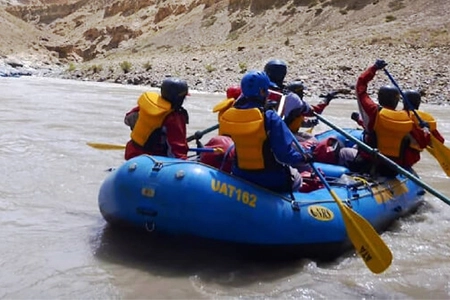

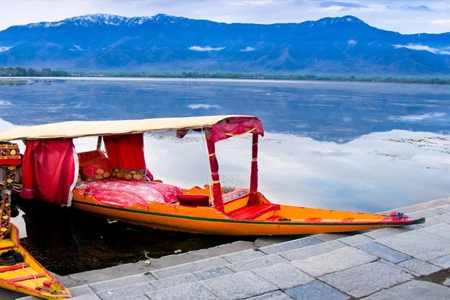
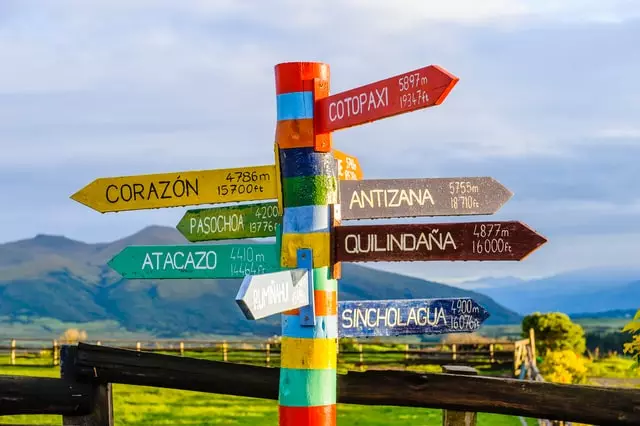
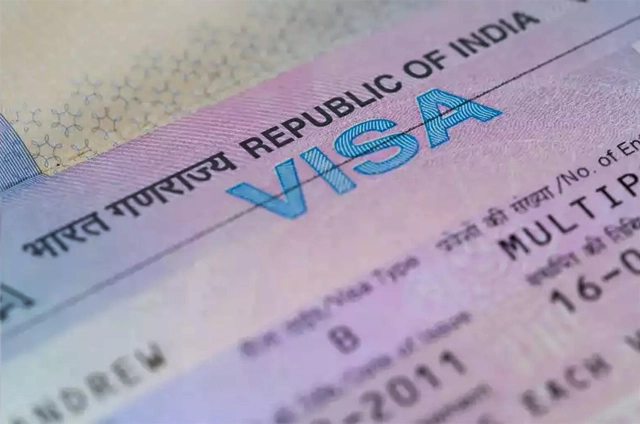
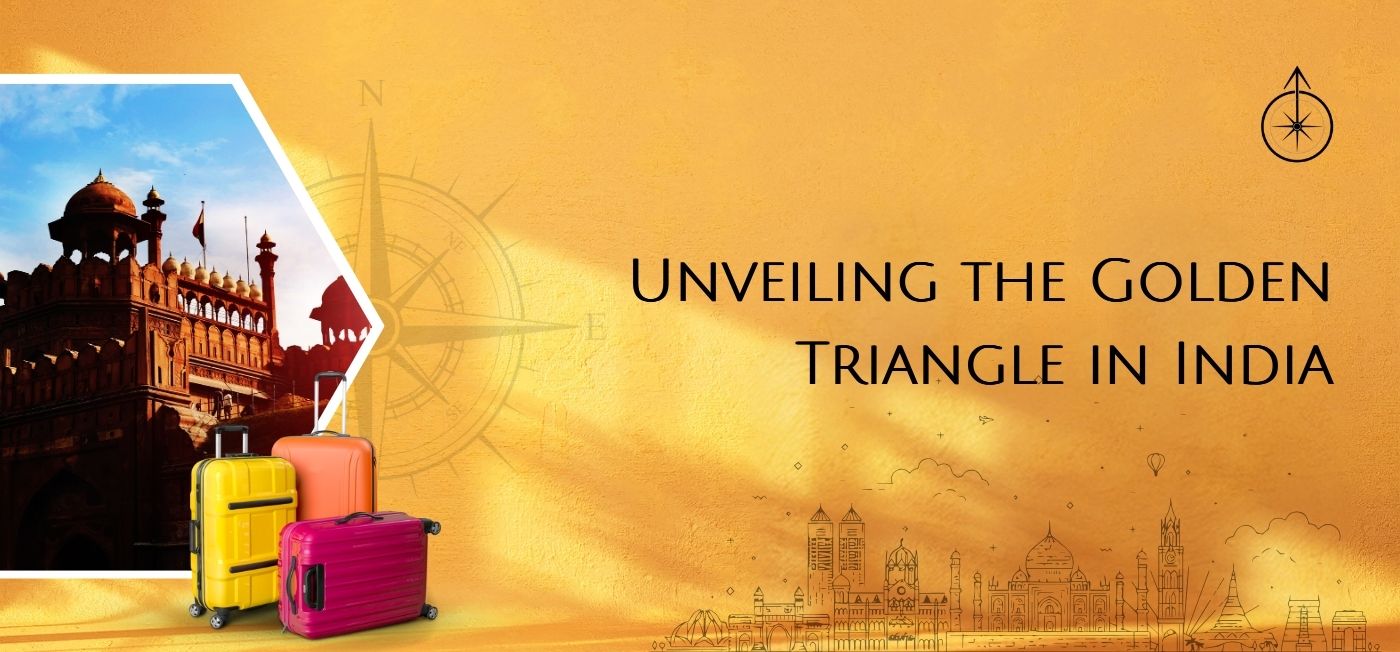







SHARE ON